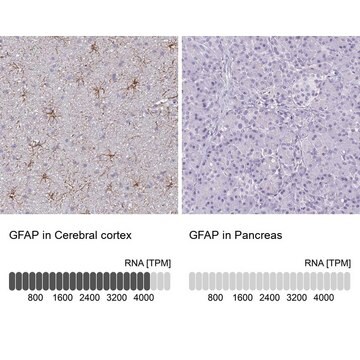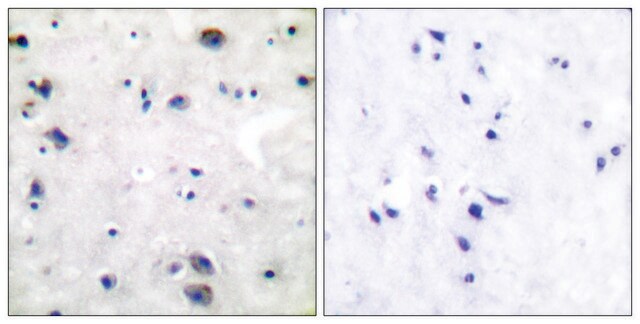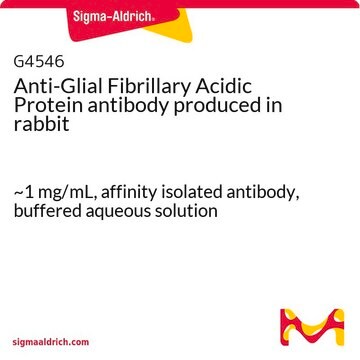SAB2107063
Anti-GFAP antibody produced in rabbit
affinity isolated antibody
Sign Into View Organizational & Contract Pricing
Select a Size
All Photos(3)
Select a Size
Change View
About This Item
UNSPSC Code:
12352203
NACRES:
NA.41
Recommended Products
biological source
rabbit
Quality Level
conjugate
unconjugated
antibody form
affinity isolated antibody
antibody product type
primary antibodies
clone
polyclonal
form
buffered aqueous solution
mol wt
46 kDa
species reactivity
rat, mouse, human, rabbit, dog
concentration
0.5 mg - 1 mg/mL
Immunogen
Synthetic peptide directed towards the N terminal of human GFAP
Biochem/physiol Actions
GFAP, a class-III intermediate filament, is a cell-specific marker that, during the development of the central nervous system, distinguishes astrocytes from other glial cells.
Sequence
Synthetic peptide located within the following region: FSLAGALNAGFKETRASERAEMMELNDRFASYIEKVRFLEQQNKALAAEL
Physical form
Purified antibody supplied in 1x PBS buffer with 0.09% (w/v) sodium azide and 2% sucrose.
Disclaimer
Unless otherwise stated in our catalog or other company documentation accompanying the product(s), our products are intended for research use only and are not to be used for any other purpose, which includes but is not limited to, unauthorized commercial uses, in vitro diagnostic uses, ex vivo or in vivo therapeutic uses or any type of consumption or application to humans or animals.
Not finding the right product?
Try our Product Selector Tool.
Storage Class
10 - Combustible liquids
wgk_germany
WGK 3
flash_point_f
Not applicable
flash_point_c
Not applicable
Choose from one of the most recent versions:
Certificates of Analysis (COA)
Lot/Batch Number
Don't see the Right Version?
If you require a particular version, you can look up a specific certificate by the Lot or Batch number.
Already Own This Product?
Find documentation for the products that you have recently purchased in the Document Library.
Customers Also Viewed
Aswin Hari et al.
Scientific reports, 7(1), 9836-9836 (2017-08-31)
Enhanced postnatal care (EPC) increases resilience to adversity in adulthood. Since microglia participate in shaping neural circuits, we asked how ablation of an inflammation-suppressing factor IRF2BP2 (Interferon Regulatory Factor 2 Binding Protein 2) in microglia would affect the responses to
Weigang Cui et al.
Molecular medicine reports, 22(2), 739-750 (2020-05-30)
Cognitive impairment and neuro‑inflammatory responses are the distinctive characteristics of Alzheimer's disease (AD). Tormentic acid (TA) is one of the major active components of Potentilla chinensis and has been demonstrated to have anti‑inflammatory properties. However, the potential effects of TA on
Our team of scientists has experience in all areas of research including Life Science, Material Science, Chemical Synthesis, Chromatography, Analytical and many others.
Contact Technical Service














